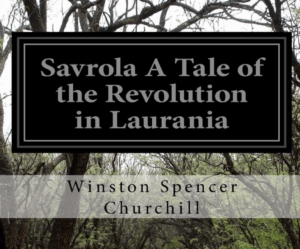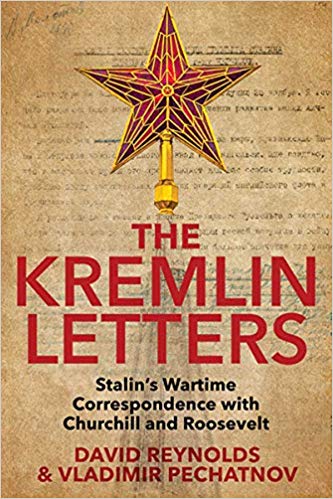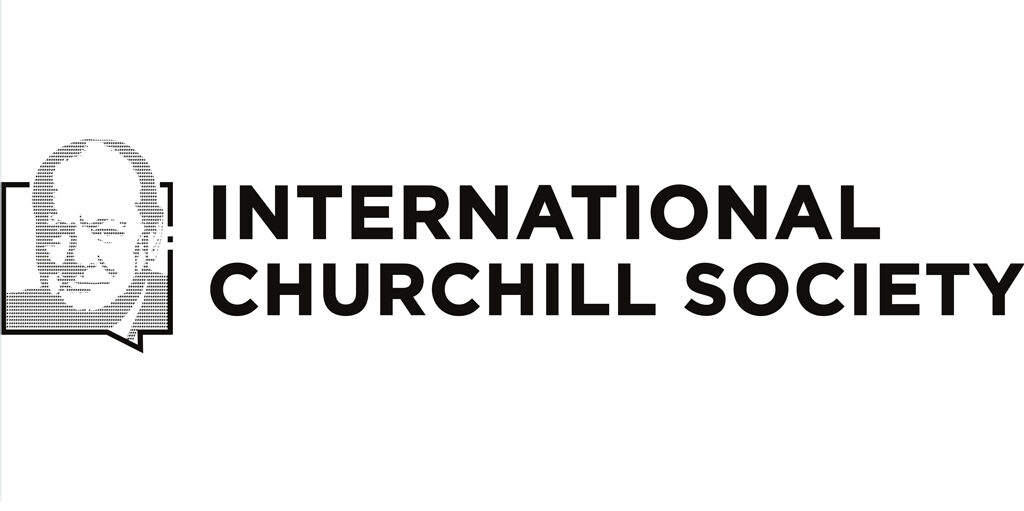
Finest Hour 183
Books, Arts, & Curiosities – Red Alert

April 27, 2019
Finest Hour 183, First Quarter 2019
Page 46
Review by Nigel Hamilton
Nigel Hamilton is Senior Fellow in the McCormack Graduate School, University of Massachusetts Boston. War and Peace, the final volume of his “FDR at War” trilogy, will be published in May 2019.
David Reynolds and Vladimir Pechatnov, eds., The Kremlin Letters: Stalin’s Wartime Correspondence with Churchill and Roosevelt, Yale University Press, 2018, 660 pages, $35. 978–0300226829
At first glance The Kremlin Letters: Stalin’s Wartime Correspondence with Churchill and Roosevelt promises to be the book we—those of us still deeply interested in the history of the Second World War—were waiting for. David Reynolds is a distinguished historian of Anglo-American relations and Vladimir Pechatnov a leading scholar of Soviet relations with the West, having access to significant new primary sources.
The good news for readers is that the seventeen-page introduction—clearly penned by Professor Reynolds—is worth the price of the book alone: a wonderful, essayistic tour d’horizon of the three great leaders of the Allied coalition in the Second World War: their different personalities, their political aims, and their strengths and weaknesses, spiced with wonderful quotations. Told in 1944 that they resembled the Holy Trinity, Marshal Stalin—who had studied for six years at the Tiflis Russian Orthodox seminary—quipped: “If that is so, Churchill must be the Holy Ghost. He flies around so much.”

2025 International Churchill Conference
And fly the leaders did—even Stalin, who was mortally afraid of taking wing, when finally agreeing to go to Yalta. For his part Franklin Roosevelt was the first U.S. president to fly while in office, and Winston Churchill clocked up 100,000 air miles during the war, much of it in an unheated converted bomber. Their summits have been exhaustively recorded and analyzed by historians. It is in their correspondence with each other, however, that we can trace the trajectories of their relationships in an age before secure telephone communications.
This secret, high-level, personal wartime correspondence—man to man, with a little help from their advisers—was pursued in coded telegrams or cables: careful encryption and decryption that was never broken by German or Japanese codebreakers. Conversely, both German and Japanese high-level codes were broken by British and American cryptologists: the so-called Ultra and Magic services, which did so much to help win the war for the Allies. Most memorable, in this respect, was the moment when, on 7 December 1941, the President of the United States was given the decrypt of a Japanese signal from Tokyo to Washington telling its two Japanese ambassadors to destroy their coding equipment immediately upon receipt, in preparation for cessation of peaceful relations and the onset of Japanese military attack—the cables decrypted by American codebreakers several hours before the ambassadors themselves had decoded them!
The encoded signals among Roosevelt, Churchill, and Stalin, by contrast, enabled the main three United Nations (as FDR called them) to wage successful warfare against the Axis powers for almost four years. Anyone who reads the diaries of Joseph Goebbels will be aware how, as the initially successful Nazi conquest of Europe turned towards defeat, both he and Hitler clung to their only remaining hope, once their Vergeltungswaffen, or weapons of revenge (V-1 and V-2 missiles) failed to dent the Allied onslaught: namely, that the Allied coalition might break apart. As Hitler remarked to Goebbels, “Coalition wars never survive the coalitions with which they start”—both men calculating that, if the Wehrmacht could only hold back the Allies, they could negotiate their way out of surrender. The Wehrmacht could not hold back the Allies, however.
The Kremlin Letters, then, promises to spotlight the prosecution of the war as a coalition of Allied nations against the Axis Powers at the very highest level. The question is: how can an editor do justice to the extraordinary cables exchanged by the three Allied leaders as letters, and at the same time explain them, in retrospect, as historians?
This is a tough problem, as anyone who has ever “edited” and “annotated” correspondence will be aware. Letters, like diaries, allow us to peer into the mind of the sender: not only the content of his thoughts, but the style and personality with which he expresses them. Published collections of letters are thus prized for their literary value as much as for their information—and in the case of Churchill we are talking about one of the greatest writers of the twentieth century, who won the Nobel Prize for Literature. Pitting his letters to Stalin against Stalin’s to him, and Roosevelt’s to Stalin and the reverse, permits us to eavesdrop, so to speak, on one of the greatest wartime triumvirates since Roman times.
Alas, if you publish their letters (or 75% of the total, in the case of The Kremlin Letters) and then dare go beyond the kind of unvarnished annotations which normal editors of famous letters adopt, you threaten to compete: first with the cable-writers’ styles, second with the sheer drama of their literary personalities and political personas in the midst of history!
The competition is certainly fierce. Reynolds is a professor of international history at Cambridge University, Pechatnov at Moscow University, and they draw on a vast range of sources and materials to introduce and subject each exchange of telegrams to their retrospective judgment, larded with pertinent diary entries and quotes from the memoirs of participants in the war. The 660 pages of The Kremlin Letters thus becomes a battle not with Hitler (for whom there are only six meager entries in the index) and his top opponents, but between the two professors today and the three Allied leaders in 1941–45. To heighten the contest, the text of the professors’ work is in one typeface, the texts of the leaders’ historic cables in another.
Different readers will accord different points or marks to this extraordinary bout—one that may well be unique in book history relating to the Second World War. Reynolds is well known for his accessibly written diplomatic histories, as well as for In Command of History (2005), his brilliant narrative analysis of Churchill’s six-volume memoirs of The Second World War, while Pechatnov has had privileged access to the Kremlin archives. Yet the more impressively the professors perform, the more they threaten to dim the very lifeblood of all collections of letters: in this case the colorful drama and individual personalities of the three leaders as, in their encrypted letters, they mount their own contest to maintain the coalition, defeat Hitler, and prepare for the aftermath: the postwar. Too often the fire and counterpoint of the leaders’ sallies comes across as mere repetition of what the professors have already introduced and explained.
For myself I find this a perplexing quasi-boxing match, and hope historians contemplating other such projects will take note. It is not the fault of the professors, of course, who are clearly brilliant men, but of the publishers seeking to put on such a misguided show, as I see it. Certainly the book is virtually impossible to read as a consistent narrative, the reader torn alternately between pre- and post-explanationism, with sans-serif cables sandwiched in between—cables that are, in turn, not even complete. As Field Marshal Montgomery was wont to say, the result is, inevitably, a “dog’s breakfast.” Whereas, had the publisher commissioned Professors Reynolds and Pechatnov to prepare the work in two volumes, similar to the method used, for example, by Randolph Churchill in the biography of his father (one volume of narrative, one companion volume of the documents), we would have what we most need: the complete originals, briefly annotated, and the more expansive explanations, seven decades later.
Perhaps it is not too late for that to be done—for there is no harm in acknowledging a mistake, and Yale University Press is a most professional publisher, committed to the study of history. I have one further suggestion to make, however, if this path is taken in due course. It concerns the historians’ explanatory narrative.
Neither Reynolds nor Pechatnov is a military historian—and in this particular case we are embracing a history of war, not peace. The virtual absence of Adolf Hitler in the book is deeply worrying; the relative absence of Hitler’s Wehrmacht even more so. In their attempt to give rational, extended diplomatic explanations for the three Allied leaders’ four-year intercourse, Reynolds and Pechatnov fail, in my view, to give weight to the enormity of the war as war: a war of battles, tactics, strategies, commanders, and commands. Dieppe—a miniD-Day raid in 1942—left almost a thousand Canadians dead on the beaches of northern France within a few hours, and thousands more wounded and captured; it does not even merit mention in the authors’ index, and only a throwaway line in their text, which will disappoint Canadian readers especially. Similarly Churchill’s alternative to D-Day, at Anzio in January 1944, merits only a throw-away paragraph, with a silly remark about whales by the prime minister—even though it resulted in some 43,000 Allied deaths and casualties. Forty-three thousand, in battle!
The Second World War was, in the end, a matter of combat—on a massive scale. Only by mounting a successful D-Day, along with a simultaneous Russian offensive from the East that would force Hitler to fight on two simultaneous all-out fronts, could the war actually be won by the Allies—as Hitler was well aware, telling his generals in December 1943 that “if they [the Allies] attack in the West, then this attack will decide the war. If this attack is driven back, the whole affair will be over.”
The Allies did attack—both in the Normandy invasion in the West and Russia’s simultaneous Operation Bagration in the East—and the war was thereby won. That, au fond, was the ultimate, essential story of the war in the West—but one that currently only plays second or lower fiddle to Reynolds’s and Pechnatov’s diplomatic, retrospective narrative. In revising their account—especially since we are about to celebrate this year the seventy-fifth anniversary of the triumph of D-Day—I would urge the professors to take this aspect of the war more seriously, more centrally, lest we fail to honor those who gave their lives for the Grand Alliance.
Subscribe
WANT MORE?
Get the Churchill Bulletin delivered to your inbox once a month.
Oops! We could not locate your form.
Privacy



